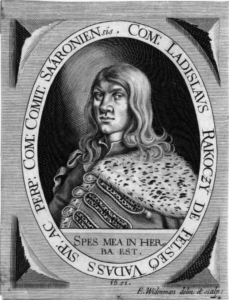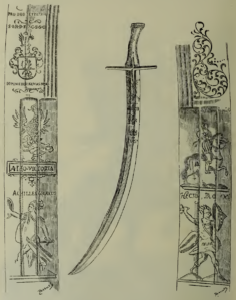Rákóczi László (1633-1664)

László came from the Roman Catholic line of the Rákóczi family, his grandfather was Prince Rákóczi Zsigmond of Transylvania. His father, Rákóczi Pál was the Chief Comes of Sáros County, his mother was Pethe Anna. They had a castle in Zboró where László was born in 1633. As his father passed away in 1636, he and his elder sister moved to Vienna where their mother also died after a few months.

László’s tutor became Bishop Lippay György of Veszprém. Lippay was giving him an education in the spirit of Cardinal Pázmány Péter who was Lippay’s predecessor. Lippay became the Bishop of Eger in 1637. László spent his childhood in the king’s court, he was the playmate of the Habsburg children. Archduke Ferdinand (later King Ferdinand IV of Hungary) was the same age as him, they learned and played together. They visited Spain in 1648, then Italy, too.

In the meantime, he completed the University of Nagyszombat (Trnava) and continued his studies in Vienna and in Graz. He inherited the rank of Chief Comes of Sáros County, and he kept in contact with his cousins, Prince Rákóczi György II of Transylvania and Rákóczi Zsigmond as well. There was an agreement between the Transylvanian prince and the Habsburg king: while Rákóczi Pál’s estates were taken care of by the Transylvanian ruler, his upbringing remained in the hand of the Habsburg monarch.
László spent altogether 15 years in the Habsburg court, he had excellent contacts with the aristocracy. His life and career were being observed by the lords of Vienna and Transylvania alike, not to mention the Hungarian aristocrats in the Kingdom of Hungary. He was an excellent go-between in the political relations of the Transylvanian Principality and the HRE. After the Treaty of Linz, the young László was anticipating a new war against the Ottomans and wanted to take part in it by all means. He had good relations with Pálffy, Nádasdy, Zrínyi, and the Rákóczi family members who were interested in joining forces against the Ottoman Turks.

Soon after his trip to Italy in 1648, he traveled to Transylvania and met his cousin, Prince Rákóczi György II for the first time. After finishing his studies, he returned to his castle in Zboró in 1651 where he successfully managed to accomplish major changes concerning his domains.
His domains had been managed by Lady Lórántffy Zsuzsanna, the widow of Prince Rákóczi György I of Transylvania. She was a supporter of the Reformed faith but she was unable to convert the Catholic László, though. Lady Lorántffy had been alienated from her Catholic son, Prince Rákóczi György II by this time, and she made her best to persuade László to switch faiths.

Although she had withheld lots of cash from László while he was studying, she tried to blackmail him emotionally to get converted, saying that she had been taking care of his Transylvanian lands during his childhood. There were Jesuit (Millei István), Franciscan (Szegedi Ferenc), and Paulinian (Vanoviczy János) monks around László who helped him to remain loyal to the Catholic Church, though.
Lady Lorántffy focused entirely on him, and she was able to undermine his marriage with the Catholic Csáky Borbála. At last, László married the Reformed Bánffy Erzsébet of Nagymihály in 1654. She was the daughter of Bánffy Ferenc and the widow of Lónyay Zsigmond. They had two children, Erzsébet (1654-1707) and Borbála who died in 1656. László’s wife passed away in 1663.

László also served in some Borderland castles, first under the command of Batthyány Ádám, then he visited Count Zrínyi Miklós aka Nikol Zrinski in 1651. He joined Zrínyi’s army and took part in the battle near Kostajnica in 1651 where they defeated the Ottoman Turks. Then, he stayed in Transylvania in 1652 for four months: he seemed to be always on the go. We know that he took part in the Diet of 1655 where he represented Sáros County. He also had a role in the coronation of King Leopold I. It was the year when he was appointed Chaimbarman and Councilor.

Rákóczi László was aspiring to gain the title of Chief Captain of Upper Hungary. He was an educated soldier and even owned a vast collection of arms but he was not an experienced general. The 22-year-old László failed to win this high rank because of his lack of military experience.
It must be mentioned that all his supporters were afraid to lose him in a battle because he was a very good diplomatic link between the Habsburgs, the Hungarians of Royal Hungary, and the Transylvanians. Thus, he had taken part only in four smaller battles in his whole life, not to mention the smaller clashes that were part of everyday life on the 1,000-mile-long Hungarian Borderland.

When Prince Rákóczi György II launched his unfortunate Polish war in 1657, Rákóczi László traveled after him to Poland, as an envoy of the Habsburg king. At the time of the Crimean Tatars’ attack, his delegation left the region, and Rákóczi described the terrible sights of war in his diary. The Transylvanian army was trapped deep in Poland.
László returned to Zboró and he could do very little to save Transylvania from the Sultan’s wrath. He tried to forward the letters from the Transylvanian army to King Leopold and sent soldiers to guard the supply wagons going to the Transylvanian army.
He ambushed several times the Turk-Tatar units that were raiding his Transylvanian domains. Also, he built a passage in the mountains on his land at Makovica where crowds of refugees could escape from Transylvania, Moldova, and Wallachia. It was the time when the relationship between László and his princely cousin became abysmal. You can read more about Prince Rákóczi György’s war here:

Things were getting worse in East Hungary and Transylvania when Pasha Szejdi launched his punishing campaign and Prince Rákóczi György II died from the wounds he got in the battle of Szászfenes in 1660. You can read several articles about these events on my page because the years between 1657 and 1664 were perhaps the darkest years in the history of the “Hungaries” (Royal Hungary, Principality of Transylvania, and the Ottoman Occupied Lands of Hungary) in the 17th century, except for the Reconquest Wars of Hungary at the end of the century. Grudgingly, the Habsburgs agreed to send troops against the Turks in 1661 but the Imperial reinforcement was not receiving enough supplies from the Hungarian counties.

At the same time, the Imperial troops began to loot the countryside and the Hungarian noblemen were protesting because of the damages. We know that General Montecuccoli and his circle in Vienna were not very friendly towards the Hungarians, Montecuccoli was a lethal enemy of Zrínyi Miklós, too. Rákóczi László wrote a letter to the Palatine in which he complained that the mercenaries looted his manor house (rather a palace) at Szentmiklós, and burned 66 houses. However, his determined complaints just made his position in Vienna weaker.

Finally, just like Zrínyi and so many Hungarian and Croatian estates, he got disillusioned with the Habsburgs’ politics. Knowing the future deeds of Emperor Leopold, their disappointment can be justified. After this, Rákóczi László began to focus on organizing a group of supporters in Transylvania during his last years. He was a good diplomat and soldier, and if he had survived the siege of Várad, he might have become a strong participant in the Wesselényi Conspiracy against the Habsburgs. Perhaps the plot would not have collapsed so shamefully if he had been there.
The ambush of Várad castle and the death of Rákóczi László on 27 May 1664





Rákóczi László wrote a Diary between 1653 and 1658. He wrote it in the Hungarian language or sometimes dictated it to his secretary. This writing is a great source of contemporary social life. We can come to know a vibrant and life-loving young aristocrat who was always traveling, visiting his relatives who were the key figures of 17th-century Hungary and Transylvania.
His castle of Zboró was not a lonely place without guests, and there is excellent information in his Diary about the events of the Diet of 1655 as well. It gives us a special insight that is rarely available from that age. Here is a reconstruction video of Zboró castle, made by Fodor Zsolt:

László had a trusted man, a Polish man called Luzsénszky Sámuel who took care of his domains. Later, László’s famous Diary was discovered in Luzsénszky’s archives in Osgyán, after 200 years. Also, the death of Rákóczi László became a source of a ballad in the 17th century. Let us commemorate him, a brave member of the Valiant Order, and let us lament his early death.
Dear Readers, I can only make this content available through small donations or by selling my books or T-shirts.
If you like my writings, please feel free to support me with a coffee here:
You can check out my books on Amazon or Draft2Digital, they are available in hardcover, paperback, or ebook:
https://www.amazon.com/dp/198020490X
or at https://books2read.com/b/boYd81


My work can also be followed and supported on Patreon: http://Become a Patron!



